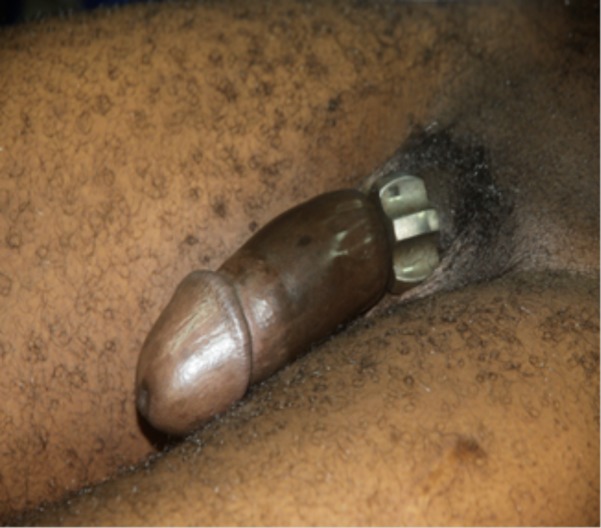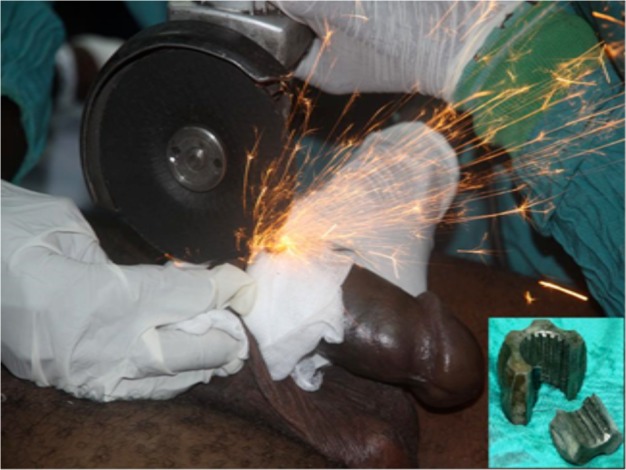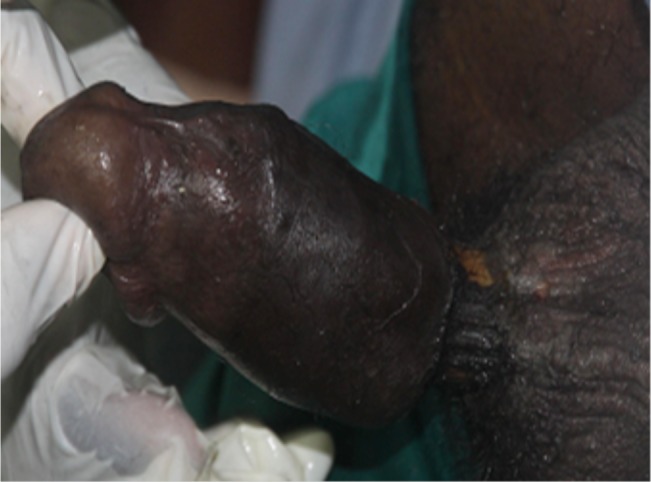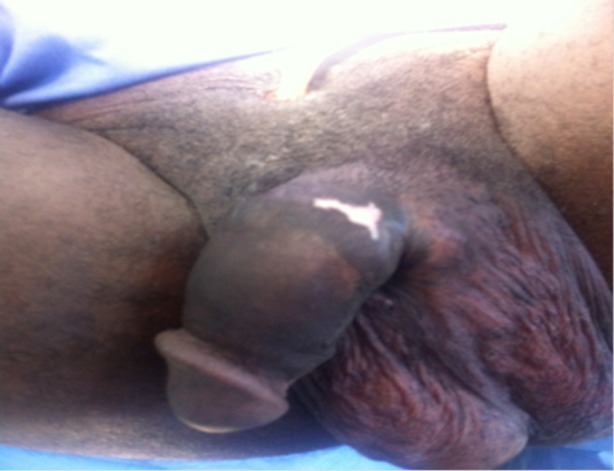Summary
We report a case of a 37-year-old male who presented with a 12-hour history of a strangulating 2cm wide by 0.8 cm thick metallic nut on the penile shaft at the peno-scrotal junction. Unlike instances where these metallic objects are placed to enhance sexual stimulation this nut was rather placed to prevent intercourse. A Bosch electric circular grinder was successfully used for removal but a thermal burn to the penile tissues was sustained in the process as the hardness of the nut required a high energy to cut and its thickness did not allow for effective cooling during the process of removal. This resulted in a circumferential denudation of penile skin, a urethro-cutaneous fistula at the peno-scrotal junction and a mid-bulbar urethral stricture. The penile wound was subsequently covered with a split skin graft with a delayed closure of the urethrocutaneous fistula and a buccal mucosa patch urethroplasty for the mid bulbar stricture. Despite the degree of thermal burns sustained the patient has maintained good erectile function with grade four rigidity. The tunica albuginea and the underlying corpora cavernosa have shown a significant degree of resilience to thermal burns compared to the corpora spongiosum where the thermal burns led to a urethrocutaneous fistula.
Keywords: Penile Strangulation, Metallic Nut , Thermal Burns , Corpora Cavernosa , Urethrocutaneous Fistulae
Introduction
There are reported cases of genital strangulation by metallic objects. The offending objects include steel rings, wedding rings, nuts, ball bearings, washers and other devices.1,2 Most of these cases have had the materials placed for erotic purposes. If these strangulating objects are left in place, it leads to the development of a penile compartment syndrome from an initial obstruction of both venous and lymphatic outflow distal to the object. There is a subsequent arterial inflow obstruction and a resulting tissue ischaemia and necrosis.3
In order to avoid penile skin loss, erectile dysfunction, urethrocutaneous fistula and ultimately penile loss, the management calls for an emergency removal of the constricting object. Due to the wide variety of strangulating objects used, various equipment's and techniques have been employed to facilitate the removal of the constricting objects. As has been observed, each case of a strangulating penile ring or nut needs individual handling with respect to the choice of an appropriate device to use for the removal, depending on the type, size, incarceration time, and availability of equipment. Some of the equipment's have been noted not to be widely available in many health facilities and hence each case presents its own challenges in removal.2,4
Case Report
A thirty-seven year old male student at a tertiary institution, reported at the surgical emergency center of the Korle Bu Teaching Hospital, Accra with a 2cm wide by 0.8 cm thick metallic nut around the penis located at the peno-scrotal junction. The nut had been positioned 12 hours prior to presentation. The patient with normal erectile function (international index of erectile function of 25) prior to presentation, indicated that there had been periods of marital conflict at home and during one such conflict, he had slipped the metallic ring on the flaccid penis with a liquid soap as a lubricant, to prevent the spouse's demand for intimacy.
He had picked the nut which is believed to be part of the components of a vehicle gear box from an auto mechanic garage a month before the incident.
Five hours after application of the ring the patient noticed swelling of the penile shaft and the glans penis distal to the ring, and the onset of pain at the site of the nut. An attempt to remove it himself was unsuccessful. The Patient had never used a cock ring to enhance erections and did not admit to having positioned the nut for masturbation. He had no co-morbidities and had no prior history of mental illness. There was also no history of substance abuse.
On examination, the patient appeared rather calm though in pain requiring 100mg intra-muscular pethidine to achieve pain relief. General assessment was normal including a clear mental state. Examination of the genitalia revealed a strangulating nut fixed tightly at the peno-scrotal junction with associated swelling and oedema of the distal penile shaft and glans penis( Figure 1).
Figure 1.

Strangulating nut fixed at the peno-scrotal junction
The patient was prepared for emergency surgery to remove the strangulating nut. The challenge was how to cut through the hard 2 cm by 0.8 cm thick metallic nut. The technical assistance of the engineering department of the hospital was solicited who advised the use of an electrically powered circular grinder. The surgery was done under general anaesthesia using a Bosch electric circular grinder provided by the Engineering Department of the hospital. The nut needed to be cut in two places for safe removal(Figure 2).
Figure 2.

Electric circular grinder being used to cut the nut (insert is the cut nut).
The surgical procedure took one hour to complete requiring a continuous sterile cold water irrigation of the nut with gauzes wrapped around the surrounding penile shaft. There was also intermittent breaks during the procedure all aimed at reducing the degree of thermal burns to the penis. However thermal burns were still noticed after the procedure (Figure 3).
Figure 3.

Thermal burns sustained after removal of the strangulating nut
The patient was catheterized per urethra after the procedure was completed. Some resolution of the oedema was noted at that stage.
However on post-operative day one, there was still residual swelling and oedema due to eschar from the thermal burns sustained in the course of the procedure. A dorsal slit was hence performed under a penile block using plain lignocaine injection. On post-operative day five, there was sloughing of the thermally burnt tissues resulting in a circumferential loss of penile skin and an urethrocutaneous fistula from sloughing of the involved segment of the corpus spongiosum. This was presumed to be from the thermal burns sustained as the resultant fistula was observed to extend not only distally but proximally beyond the site of the strangulating nut. The tunica albuginea of the corpora cavernosa appeared intact.
No attempt was made to close the urethra-cutaneous fistula primarily as the effect of the thermal burns and ischaemia was still evolving. A supra pubic cystostomy was therefore done to divert the urine after which the urethral catheter was removed.
The site of the penile wound resulting from sloughing of the thermally burnt tissues was dressed regularly. The site contracted an infection four weeks after the initial procedure. Citrobacter species were isolated that was sensitive to Amikacin. The patient hence had intravenous amikacin for five days. Subsequent periodic wound swabs did not isolate any specific bacterium. Healthy granulation tissue suitable for split skin grafting was achieved four months after the sloughing of the eschar. At that point a split skin graft taken from the right thigh was used to graft the penile wound over the corpora cavernosa.
The patient had a full psychiatric evaluation and was cleared of any psychiatric disorder. Six months after the split skin grafting, the patient had retrograde urethrogram that revealed multiple incomplete urethral strictures of the distal urethra that admitted an F18 foley catheter, the presence of the urethrocutaneous fistulae at the penobulbar junction and a mid-bulbar incomplete urethral stricture. The patient subsequently had closure of the urethrocutaneous fistula and a buccal mucosa dorsal onlay graft for the management of the associated mid bulbar urethral stricture.
The peak urine flow rate six weeks after the procedure was 31ml/s. Despite the degree of thermal burns sustained the patient has maintained good erectile function with grade four rigidity (Figure 4).
Figure .

4The penis after surgical management
Discussion
Most reported cases of penile strangulation involve the placement of the metallic rings and devices for sexual gratification. However our patient apparently placed the nut on the flaccid penis to prevent having sexual intercourse with his spouse, an unusual presentation.
One of the major complications in the removal of metallic strangulating objects is iatrogenic thermal burns to the underlying penile tissues as high speed cutting tools are used. These burns have been prevented or mitigated through the use of cold sterile fluids for irrigation, placing malleable retractors beneath the metallic objects, and the use of a high precision Midas-Rex pneumatic drill with metal cutting carbide attached.5
However iatrogenic thermal burns become inevitable when one is dealing with a very hard and thick metallic nut, tightly constricting and strangulating the penis after having been placed on the flaccid penis 12 hours earlier. A compounding factor is when the only available tool for removal is an electrically driven circular grinder.
Though cold sterile water irrigation was used during the procedure with intermittent breaks, it was not effective. Perhaps if there had been an effective cooling of the thick metallic nut during cutting, any significant thermal injury may have been minimized.
Despite the degree of thermal burns sustained the patient has maintained good erectile function with grade 4 rigidity (Figure 4). The tunica albuginea and the underlying corpora cavernosa have shown a significant degree of resilience to thermal burns compared to the corpora spongiosum where the thermal burns led to a urethrocutaneous fistula.
References
- 1.Patel C, Kim R, Delterzo M, Wang R. Prolonged penile strangulation with metal clamps. Asian J Androl. 2006;8:105–106. doi: 10.1111/j.1745-7262.2006.00078.x. [DOI] [PubMed] [Google Scholar]
- 2.Santucci RA, Deng D, Carney J. Removal of metal penile foreign body with a widely available emergency-medical-services air driven grinder. J Urol. 2004;63:1183–1184. doi: 10.1016/j.urology.2004.01.021. PubMed. [DOI] [PubMed] [Google Scholar]
- 3.Ivanovski O, Stankov O, Kuzmanoski M, Saidi S, Banev S, Filipovski V. Penile strangulation: two case reports and review of the literature. J Sex Med. 2007;4:1775–1780. doi: 10.1111/j.1743-6109.2007.00601.x. PubMed. [DOI] [PubMed] [Google Scholar]
- 4.Sathesh-Kumar T, Hanna-Jumma S, De Zoysa N, Saleemi A. Genitalia strangulation—fireman to the rescue. Ann R coll Surg Engl. 2009;91(4):W15–W16. doi: 10.1308/147870809X400976. [DOI] [PMC free article] [PubMed] [Google Scholar]
- 5.Cassidy DJ, Mador D. Genital incarceration: an unusual case report. Can Urol Assoc J. 2010;4(3):E76–E78. doi: 10.5489/cuaj.863. [DOI] [PMC free article] [PubMed] [Google Scholar]


